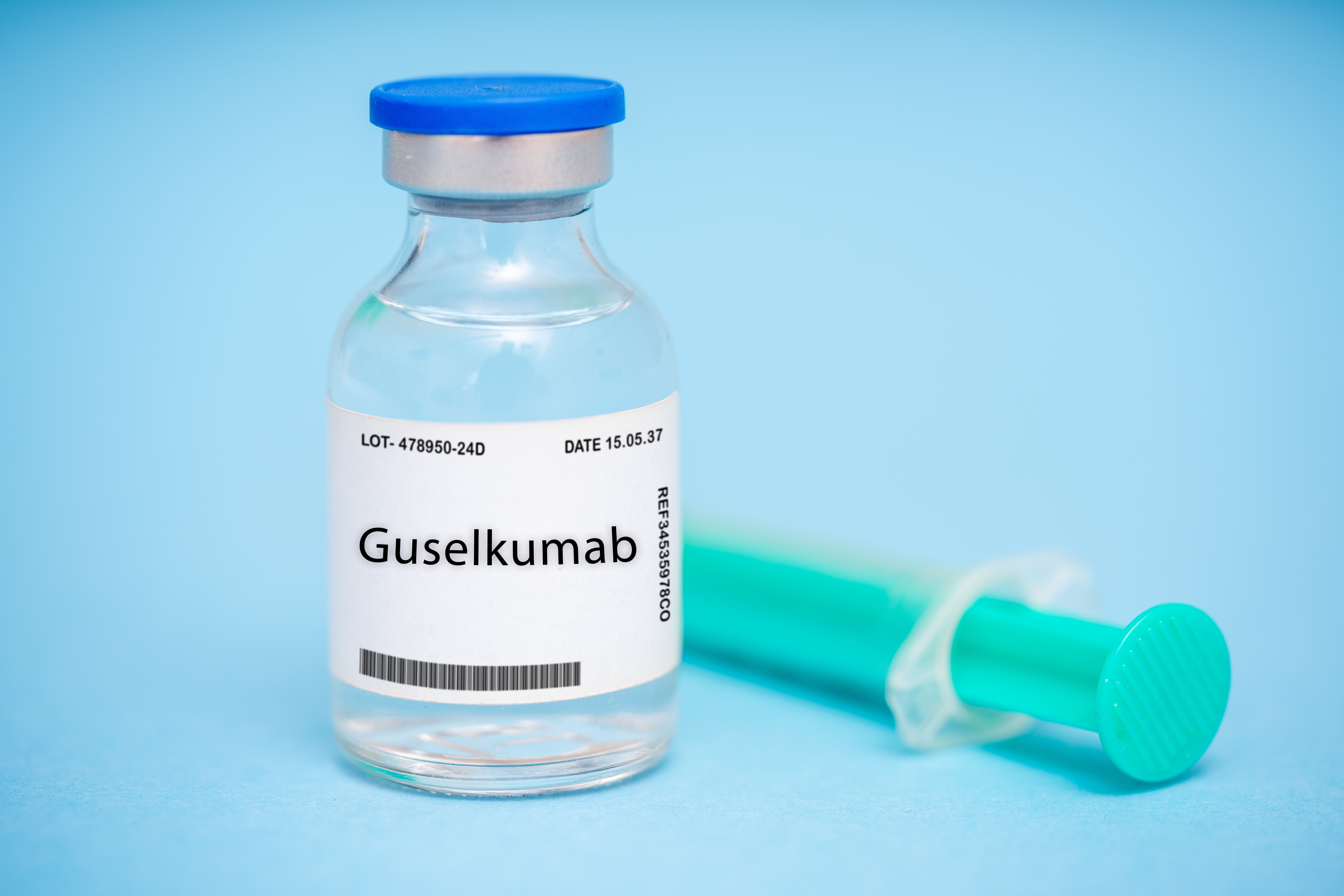News
Article
Guselkumab Shows Sustained Efficacy in Phase 3b APEX Study for Active PsA
Author(s):
Key Takeaways
- Guselkumab, an IL-23 inhibitor, is effective in reducing signs, symptoms, and structural damage in active PsA, as confirmed by the APEX study.
- The FDA approved guselkumab in 2020 based on DISCOVER trials, showing significant ACR20 response rates compared to placebo.
Long-term extension analysis of the phase 3b APEX study (NCT04882098) through 3 years of treatment will further assess the sustained efficacy of guselkumab (Tremfya; Johnson & Johnson) in limiting structural damage in patients with active psoriatic arthritis (PsA).
The phase 3b APEX study (NCT04882098) confirmed that guselkumab (Tremfya; Johnson & Johnson) reduces signs and symptoms of disease and structural damage progression in adults living with active psoriatic arthritis (PsA), according to a press release.1
Long-term extension analysis through 3 years of treatment will further assess the sustained efficacy of guselkumab in limiting structural damage in patients with active psoriatic arthritis. | Image Credit: luchschenF - stock.adobe.com

Previous Clinical Trial Results Support FDA Approval
The FDA approved guselkumab for adult patients with active PsA in July 2020.2 This made it the first and only treatment approved for this population that selectively inhibits interleukin (IL)-23, a naturally occurring cytokine involved in normal inflammatory and immune responses associated with PsA symptoms.
Guselkumab is administered as a 100-mg subcutaneous injection every 8 weeks, following 2 starter doses at weeks 0 and 4. It can be used alone or in combination with a conventional disease-modifying antirheumatic drug, such as methotrexate.
This approval was based on 2 phase 3 clinical trials, DISCOVER-1 (NCT03162796) and DISCOVER-2 (NCT03158285), which evaluated the safety and efficacy of subcutaneous guselkumab in adults with active PsA vs placebo. The results showed that a significant percentage of patients treated with guselkumab reached each study's primary end point of the American College of Rheumatology 20 (ACR20) response at week 24.
An ACR20 response is defined as both a 20% improvement in the number of tender and swollen joints and a 20% improvement in 3 of the following 5 criteria: patient global assessment, physician global assessment, functional ability measure, visual analog scale pain scale, and erythrocyte sedimentation rate or C-reactive protein.
In DISCOVER-1, 52% of patients treated with guselkumab achieved ACR20 vs 22% of those in the placebo group. Similarly, in DISCOVER-2, 64% of patients treated with guselkumab achieved ACR20 vs 33% of those in the placebo group. Both trials indicated that treatment with guselkumab improved patient symptoms, including psoriasis skin manifestations, physical functioning, and fatigue.
New Data Confirm Guselkumab’s Efficacy in Active PsA
The phase 3b APEX study further supports the efficacy of guselkumab in patients with active PsA, building on the findings from DISCOVER-1 and -2.1 APEX is a multicenter, randomized, double-blind, placebo-controlled trial involving biologic-naïve patients with active PsA who had inadequate responses to standard treatments.
The study design included a 24-week placebo-controlled phase, followed by 24 weeks of active treatment and a 12-week safety follow-up period. Participants who consented received an additional 2 years of active treatment before the final safety evaluation.
The study met its primary end point of ACR20, demonstrating a reduction in signs and symptoms of active PsA. APEX also achieved its secondary end point of reducing structural damage progression in patients treated with guselkumab, as measured by radiographic progression at week 24.
Looking ahead, long-term extension data over 3 years will further assess the sustained efficacy of guselkumab in preventing structural damage in patients with active PsA. These results will be presented at upcoming medical meetings.
“PsA can be a progressive and debilitating disease, and without early identification and treatment, patients may experience irreversible joint damage that significantly impacts their daily activities," Terence Rooney, vice president and rheumatology disease area leader at Johnson & Johnson Innovative Medicine, said in a press release. "These new topline data highlight the importance of addressing both inflammation and structural damage at the source as early as possible. As the only IL-23 treatment to show significant inhibition of structural damage, Tremfya equips health care providers with critical data so their patients do not have to compromise their future joint health.”
References
- Tremfya (guselkumab) is the first and only IL-23 inhibitor to significantly reduce both the signs and symptoms and the progression of structural damage in adults living with active psoriatic arthritis. News release. Johnson & Johnson; April 4, 2025. Accessed April 8, 2025. https://www.jnj.com/media-center/press-releases/tremfya-guselkumab-is-the-first-and-only-il-23-inhibitor-to-significantly-reduce-both-the-signs-and-symptoms-and-the-progression-of-structural-damage-in-adults-living-with-active-psoriatic-arthritis
- Tremfya (guselkumab) approved by US Food and Drug Administration as the first selective interleukin (IL)-23 inhibitor for active psoriatic arthritis. News release. Johnson & Johnson; July 14, 2020. Accessed April 8, 2025. https://www.jnj.com/media-center/press-releases/tremfya-guselkumab-approved-by-u-s-food-and-drug-administration-as-the-first-selective-interleukin-il-23-inhibitor-for-active-psoriatic-arthritis




